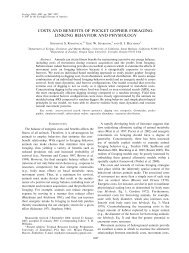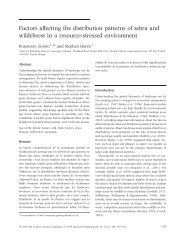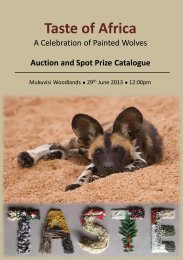The feeding ecology of the aardvark Orycteropus afer - ResearchGate
The feeding ecology of the aardvark Orycteropus afer - ResearchGate
The feeding ecology of the aardvark Orycteropus afer - ResearchGate
You also want an ePaper? Increase the reach of your titles
YUMPU automatically turns print PDFs into web optimized ePapers that Google loves.
138 W. A. TAYLOR ET AL.<strong>The</strong> following were recorded during each 2 h observation period:(1) Prey species identification;(2) Feed bout lengths (s). In 1997 <strong>the</strong> time was recorded from when <strong>aardvark</strong>sstarted digging into an ant nest, to when it stopped inserting its snout into <strong>the</strong> dig.In 1998 it was recorded as <strong>the</strong> length <strong>of</strong> time <strong>the</strong> <strong>aardvark</strong> collected food,indicated by movement <strong>of</strong> <strong>the</strong> hyomandibular apparatus. This differencewas not important.(3) Depth <strong>of</strong> food digs (cm).Whenever an <strong>aardvark</strong> fed from an epigeal mound <strong>of</strong> Trinervitermes trinervoides, <strong>the</strong>following information was recorded:(1) Mound height: small (20 cm, medium 20–40 cm, and large '40 cm. <strong>The</strong>height <strong>of</strong> a mound was used as an index <strong>of</strong> population size since <strong>the</strong> twomeasurements are highly correlated (Adam, 1993);(2) Whe<strong>the</strong>r or not <strong>the</strong> mound had been previously excavated;(3) <strong>The</strong> side <strong>of</strong> <strong>the</strong> mound opened up (north, south, etc.).Calorific values <strong>of</strong> ants and termitesCalorific values <strong>of</strong> six prey species eaten in large numbers were determined usinga CP400 Mini Calorimeter (Cambridge Instruments). Soldiers, workers and alates <strong>of</strong>T. trinervoides were tested separately to compare calorific values between castes, whileA. custodiens were collected in both summer and winter to compare seasons.Estimation <strong>of</strong> densities <strong>of</strong> termite moundsOne hectare sampling grids were temporarily marked out at 10 sites within known<strong>aardvark</strong> home ranges. Within each grid <strong>the</strong> number <strong>of</strong> epigeal T. trinervoides moundswere counted and categorized by height and whe<strong>the</strong>r or not <strong>the</strong>y had been previouslyexcavated.Prey choice and prey value<strong>The</strong> major prey species in <strong>the</strong> diet <strong>of</strong> <strong>the</strong> <strong>aardvark</strong> were assessed according to fivevariables considered most likely to be important in affecting prey choice, usingmethods adapted from Swart et al. (1999). Variables were:(1) <strong>The</strong> abundance <strong>of</strong> each species as indicated by pitfall trapping carried out at TdR(Lindsey & Skinner, 2001). Grassland results were used as this was <strong>the</strong> habitat inwhich <strong>aardvark</strong>s fed most <strong>of</strong>ten. Abundance figures were scaled from 1 to 50,with each increment <strong>of</strong> one indicating an increase in abundance <strong>of</strong> 50 ants.A figure <strong>of</strong> 1, <strong>the</strong>refore, indicates an abundance <strong>of</strong> 1–49, 2"50–99, etc. Abundance<strong>of</strong> T. trinervoides was estimated from <strong>the</strong> average density <strong>of</strong> epigeal mounds,from which termite density could be estimated using figures from Adam (1993);(2) Prey size. A volumetric estimate was obtained using <strong>the</strong> equation:Volume"Length (L) * Width (L/4) * Depth (L/5)Each species length was measured and averaged from 10 specimens;(3) Average dig depth. This was included to represent <strong>the</strong> depth <strong>of</strong> subterraneannests and, <strong>the</strong>refore, <strong>the</strong> effort expended by <strong>the</strong> <strong>aardvark</strong>s.





